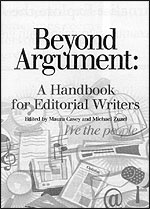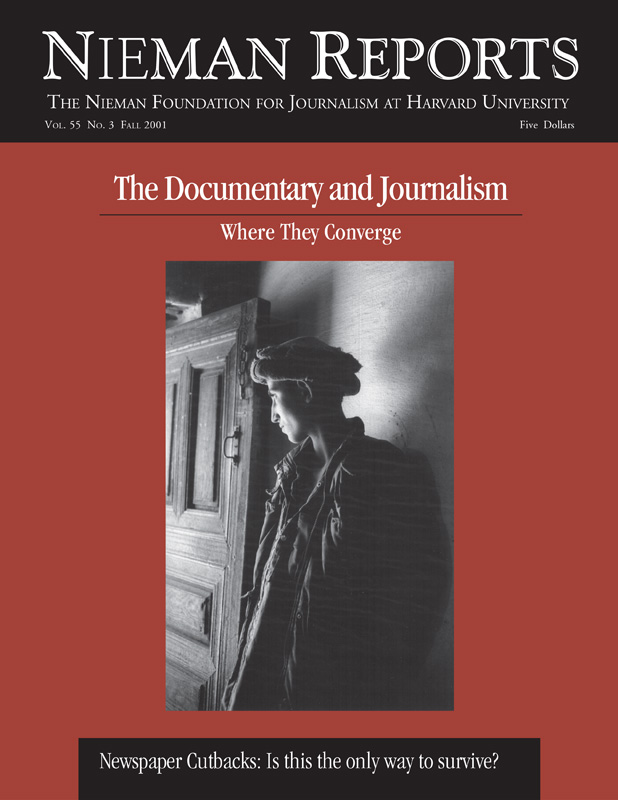
Beyond Argument: A Handbook for Editorial Writers
Maura Casey and Michael Zuzel, Editors
National Conference of Editorial Writers. 120 Pages. $24.95.The pithier the better: “The basic idea that all of us ought to have tattooed on some visible appendage is that the best editorials focus on a single idea. Just one. Not two,” writes Richard Aregood, who won the 1995 Pulitzer Prize for Editorial Writing at The Philadelphia Daily News. After a 28-year career in Philadelphia, Aregood joined The (Newark) Star-Ledger, where he edits the editorial page. He is one of 11 editorial writers whose visions and practical advice are collected in this valuable handbook, part of the Scripps Howard Foundation’s “Role Model Series.”
The National Conference of Editorial Writers (NCEW) undertook this project in part because “a good many editorial writers enter the craft suddenly and without formal preparation,” writes Francis L. Partsch, editorial page editor of the Omaha World-Herald. Writing with this audience in mind explains why some of the advice sounds basic. Other points, however, should spark discussion among veteran editors, writers and managers, especially the passages addressing new ways of doing business without sacrificing the core of this oldest form of American journalism, opinion writing.
Aregood says one of his all-time favorite editorials bore the headline: “Adios, Dictator.” Its full text read: “They say only the good die young. Generalissimo Francisco Franco was 82. Seems about right.” In retrospect, Aregood writes, the last sentence is superfluous.
Brevity has its advantages, but in recent years editorial series, resulting from months of enterprise reporting, have made significant and enduring differences and gained the attention of the Pulitzer board. John Bersia calls his Orlando Sentinel series, “Fleeced in Florida,” “the most intensive reporting project of my career.” And Maria Henson—who is now deputy editorial page editor of the Austin American-Statesman—worked on an editorial series for 16 months, including the year in which “To Have and To Harm: Kentucky’s Failure to Protect Women From the Men Who Beat Them” appeared in the Lexington Herald-Leader.
Pungent, profound or path breaking, the editorials cited in this book, along with ways to achieve similar excellence, are important for all journalists to read. However, the book will be most helpful to those who must pick up the slack when talented editorial writers are off doing projects. Practical advice ranges from filling the page to keeping up morale.
Though some attention is devoted to electronic media, the emphasis is on newspapers and their online counterparts. This is, perhaps, because it is rare that local or network television has its own editorial board or director. One exception is WISC-TV in Madison, Wisconsin, where Editorial Director Neil Heinen says he hopes the station’s online site will help foster more interactivity with viewers.
Several writers address the Internet, both as a resource and as a way to get communities of all sizes more engaged. As a reference source, the Internet allows editorial writers to more quickly and comprehensively examine primary documents. Danny Glover (the managing editor of National Journal’s Technology Daily, not the actor) suggests ways to connect opinion pages to the Internet. These include moderated forums, readers’ logs (such as links in Jim Romenesko’s daily media column at www.poynter.org), and interactive editorial boards.
Michael Zuzel, co-editor and editorial writer and columnist for The Columbian in Vancouver, Washington, calls the editorial page “the original interactive mass medium.” Letters to the Editor are still vital, he says, but he recommends readers use the Web to immediately access previous stories and background on current topics, and he suggests www.intellectualcapital.com, one of the book’s many tips and useful references. Susan Albright, editor of the (Minneapolis) Star Tribune editorial pages, who is credited with conceiving this book, offers down-to-earth management advice—from bringing doughnuts occasionally to doing “those dratted performance reviews on time. Your staff wants your feedback, and they deserve the raise now.”
To this day, too many editorial pages remain a stodgy and serious gray, all type and no action. This is a serious mistake. Even something as simple as running the editorial cartoon in color makes a difference. One clear editorial point, surrounded by photos, can have dramatic impact. The Spokesman-Review in Spokane, Washington ran biographies and photos of 35 people killed in 1999 on “The Highway of Heartache” to accompany an investigative series on the deadly Idaho portion of U.S. Route 95. More radical are standalone editorial graphics: The New York Times’s “Op Art” is sometimes a single image, but on July 3, 2000, the editors published 35 close-up photos of people holding American flags with the headline, “What is America?”
Though Howell Raines, the New York Times editorial page editor recently named executive editor of the newspaper, is quoted in several essays, smaller and mid-sized newspapers are abundantly featured. In fact, several writers argue persuasively that editorial board meetings at some larger news organizations get in the way of doing a good job.
George B. Pyle, a columnist and editorial writer for The Salina (Kansas) Journal, was a finalist for the 1998 Pulitzer Prize. That year it was won by Bernard Stein, who writes for his family’s weekly neighborhood newspaper, The Riverdale Press, in New York. The other finalist was Clint Talbott of the Colorado Daily in Boulder. Later that year, these three men appeared on a panel at the NCEW convention. Pyle writes of their common ground: “‘We noted that each of us had the freedom to write what interested and moved us, without the need to first convince other members of an editorial board.’ Panel moderator Phil Haslanger, managing editor of The Capital Times in Madison, Wisconsin, instantly labeled this circumstance, ‘Room, but no board.’”
Paul Greenberg, editorial page editor of the Arkansas Democrat-Gazette, says columnists are better read than many of today’s editorials and claims that it is the profession’s own fault: “Today’s editorial page oozes prudence, which is too often a euphemism for fear, especially the fear of ideas.” He advocates scrapping editorial board meetings: “They’re boring as hell and twice as long.”
The book is illustrated with black and white cartoons by Jeff Danziger and Signe Wilkinson, and it is noted that this sparest of forms is represented by staff cartoonists at fewer than one-tenth of U.S. daily newspapers. While it won’t help the employment situation of professional cartoonists in the current news economy, in this book the editors give ways to solicit cartoons from the public—and sound somewhat surprised that this has actually worked.
“In the end, the secrets are simple and the rules are few,” Aregood concludes. “If you have something to say, spit it out. If you don’t, shut up. The rest is mere technique.”
Nancy Day, a 1979 Nieman Fellow, is director of Advanced Journalism Studies at Boston University and a freelance editor and writer.



